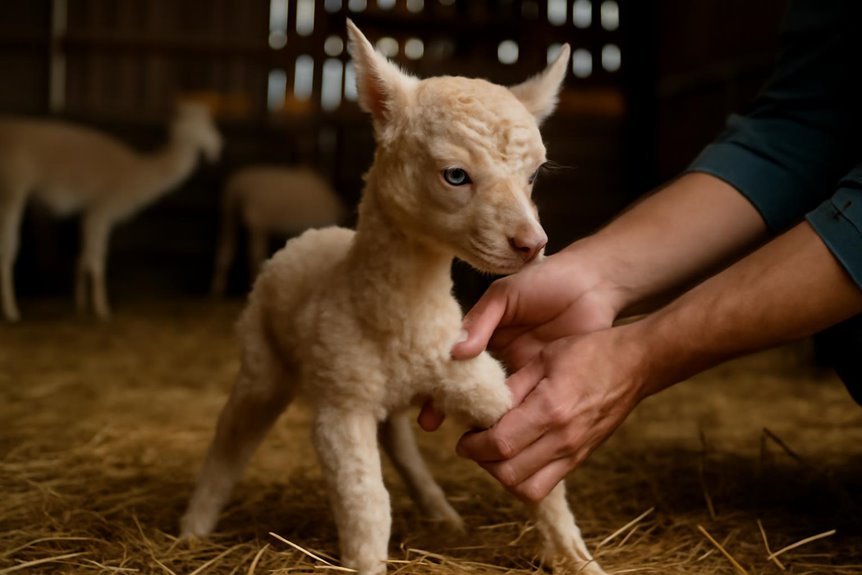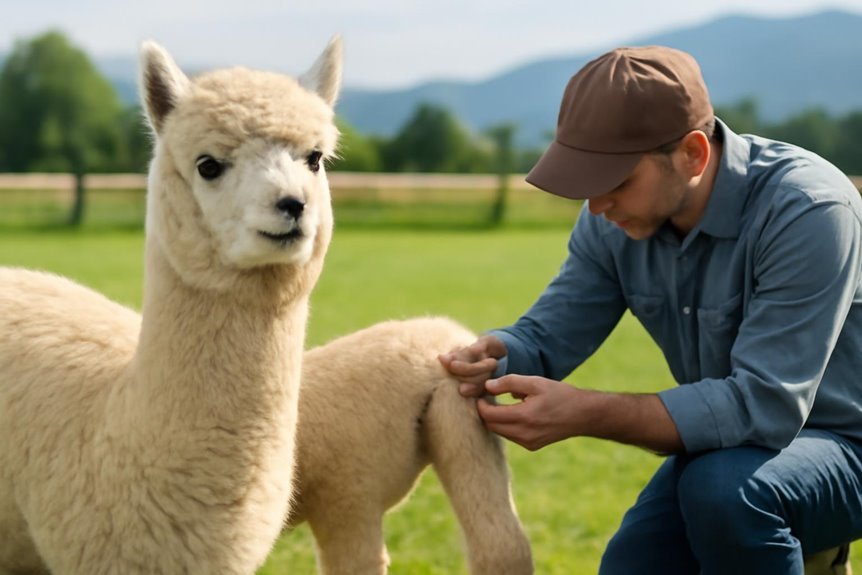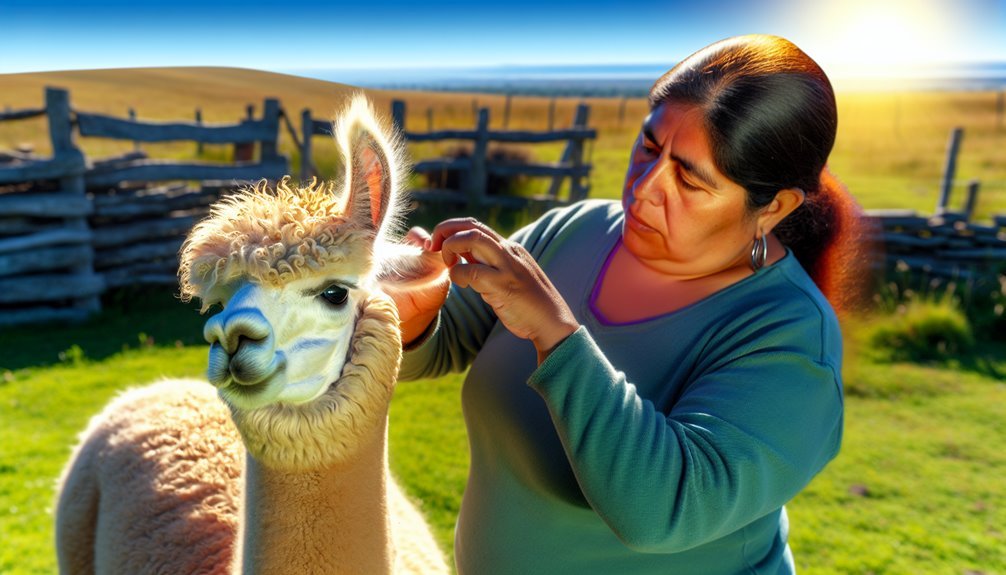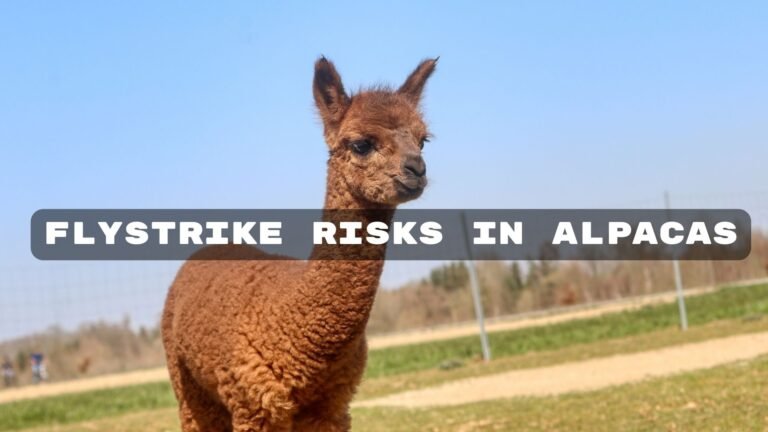Hereditary Diseases in Alpacas: What Breeders Need to Know
You need to watch for common hereditary diseases in alpacas like maxillofacial defects and metabolic issues that can harm your herd’s health and reproduction. Genetic testing helps you choose breeding pairs wisely, reducing inbreeding and congenital risks. Managing nutrition and stress lowers metabolic disorders. Prioritize genetic health over appearance to keep your herd strong and viable. If you keep going, you’ll discover effective strategies to protect and improve your alpaca breeding program.
Key Takeaways
- Congenital defects like maxillofacial dysgenesis and atrioventricular septal defects are common hereditary diseases in alpacas requiring early detection.
- Genetic testing identifies hereditary conditions, enabling informed breeding choices to reduce disease incidence.
- Prioritizing genetic health over fleece traits minimizes congenital defects and hereditary disorders in breeding programs.
- Maintaining genetic diversity and avoiding inbreeding depression are crucial for herd viability and reducing disease risks.
- Collaboration with veterinarians and geneticists ensures effective management and monitoring of inherited health issues.
Common Congenital Defects in Alpacas

Several congenital defects commonly affect alpacas, ranging from facial abnormalities like maxillofacial dysgenesis (wry face) to serious cardiac issues such as atrioventricular septal defects. These congenital anomalies often result from genetic mutations or environmental influences, making thorough veterinary evaluation essential. Compared to other camelids and livestock, alpacas show a higher incidence of such congenital defects, including choanal atresia and diaphragmatic hernia. Early detection is critical, as timely surgical corrections can improve the survival and quality of life for affected animals. If defects are severe, euthanasia might be necessary. In managing these challenges, breeding programs must prioritize identifying these congenital anomalies to reduce their occurrence, ensuring healthier alpacas and more sustainable herds. Your role as a breeder includes close monitoring and collaboration with veterinary experts to tackle these hereditary issues effectively.
Genetic Testing and Breeding Strategies
Identifying congenital defects in alpacas is just the first step in managing hereditary health issues. Genetic testing allows you to pinpoint specific hereditary conditions, helping you choose breeding pairs that reduce the risk of passing on problems. Effective breeding strategies involve balancing genetic quality and diversity to avoid inbreeding depression, which can worsen hereditary diseases. Using tools like Expected Progeny Differences (EPDs) can guide you in predicting offspring traits to improve overall herd health and conformation. To strengthen your approach, consider:
Genetic testing and balanced breeding strategies help reduce hereditary defects and improve alpaca herd health.
- Incorporating unrelated alpacas to maintain genetic diversity
- Utilizing DNA tests focused on health and conformation traits
- Regularly updating breeding strategies based on the latest genetic research
- Prioritizing genetic quality to reduce hereditary conditions and improve herd viability
Recognizing and Managing Metabolic Disorders
Although metabolic disorders in alpacas can be complex, recognizing their signs early is essential to preventing serious health issues. Conditions like hyperglycemia and insulin resistance can escalate quickly, sometimes with glucose levels exceeding 500 mg/dL in severe cases. Stress management plays a vital role in reducing the risk of these metabolic disorders. Hepatic lipidosis, the most common liver disease in alpacas, can be detected through elevated serum triglycerides and liver ultrasounds. Nutritional deficiencies, especially copper deficiency, can worsen metabolic health, causing fiber depigmentation and higher infection risk. To manage and prevent complications, you should conduct regular health evaluations, monitor body condition closely, and implement proper dietary management. Paying attention to these factors helps maintain your alpacas’ metabolic balance and overall well-being.
Preventing and Controlling Inherited Health Issues

When managing your alpaca herd, prioritizing genetic health over fleece traits is key to reducing hereditary diseases and congenital defects. Genetic selection focusing on health traits helps prevent inherited health issues before they arise. You should perform regular health evaluations and genetic testing to identify risks early. Creating a well-informed breeding plan with careful selection of breeding pairs minimizes inbreeding and genetic defects.
To effectively prevent and control hereditary diseases:
- Use genetic testing to screen for known conditions
- Monitor health traits through routine evaluations
- Develop a breeding plan that emphasizes lineage and diversity
- Collaborate closely with vet professionals and geneticists
Impact of Hereditary Diseases on Herd Viability
Since hereditary diseases can compromise both reproductive success and overall health, they pose a serious threat to your alpaca herd’s long-term viability. Congenital defects and genetic disorders increase culling rates and cause significant financial losses. Inbreeding depression worsens these effects by reducing fertility, growth, and immune function. To protect herd viability, you need detailed breeding records and use expected progeny differences (EPDs) to select for healthier traits. Genetic testing is essential for identifying carriers of hereditary diseases, allowing you to avoid breeding animals that could pass on harmful genes. By managing genetic diversity carefully and monitoring for congenital defects, you’ll minimize the impact of hereditary diseases and safeguard your herd’s future productivity and health.
Frequently Asked Questions
What Are the Problems With Alpacas Breeding?
Like maneuvering through a maze, alpaca breeding challenges you with breeding ethics, genetic diversity, and inbreeding depression. You need health screenings, genetic testing, managing reproductive challenges, age considerations, and buyer education to master herd management and prevent pregnancy complications.
What Are the Birth Defects of Alpacas?
You’ll encounter birth defects like choanal atresia and maxillofacial dysgenesis in alpacas. Prevention strategies include health screenings, parental testing, and managing nutritional and environmental factors through good breeding practices and early detection of genetic disorders.
What Vaccinations Do Alpacas Need?
Alpaca vaccinations are like a shield, protecting your herd from clostridial diseases. Follow core vaccines, maintain an annual vaccination schedule with boosters, track vaccination records, and consider timing for crias to guarantee benefits outweigh side effects.
What Is the Silent Killer in Alpacas?
The silent killer in alpacas often shows silent symptoms and can be worsened by genetic disorders. You’ll need veterinary advice, health screenings, and early detection. Understanding inheritance patterns, carrier animals, and breeding strategies helps manage risks alongside environmental factors.








Our picks
Alpaca & Wool Felted Sole Inserts: Comfy Upgrade?
Best Alpaca Socks for Hiking: Ultimate Comfort and Durability on Trails
Best Alpaca Halter for Comfort and Control